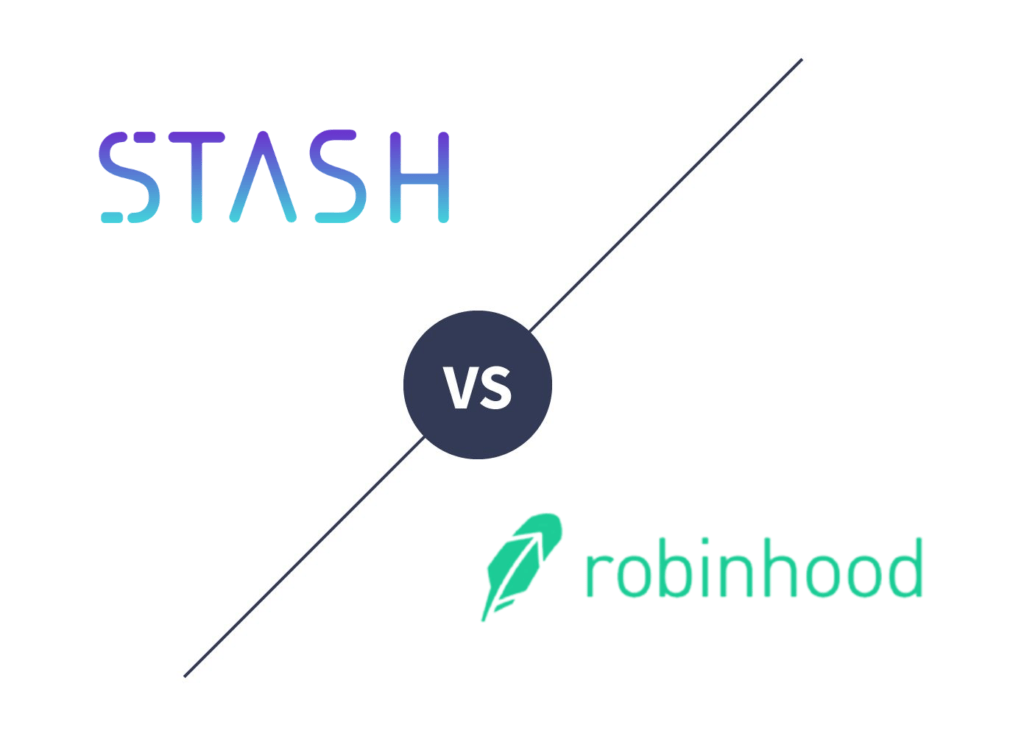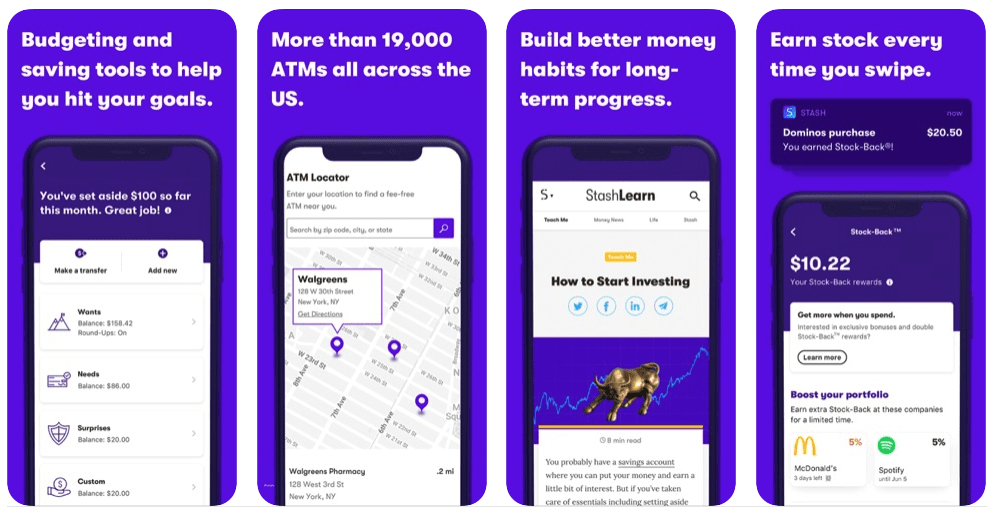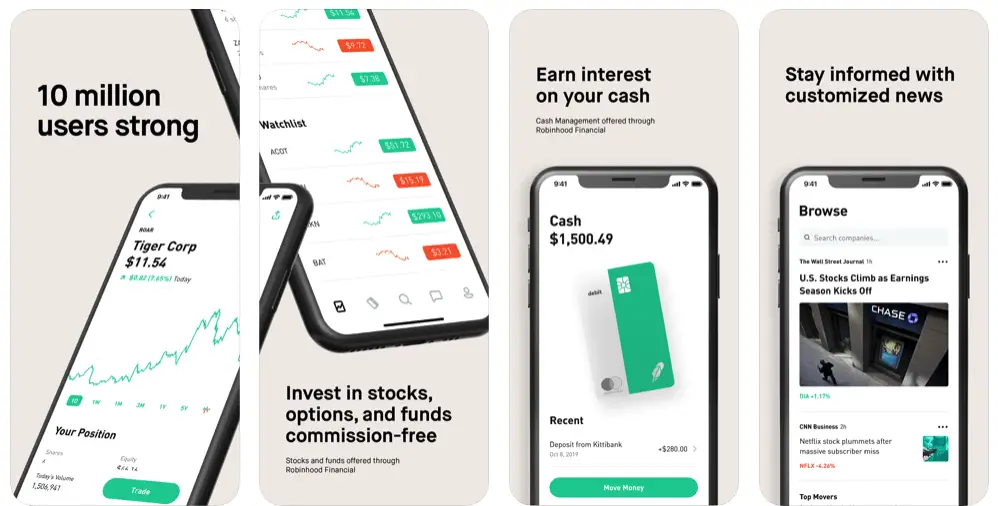
Low-fee investing platforms like Stash and Robinhood have recently surged in popularity, offering simplicity, convenience, and modern apps and interfaces. Here we'll compare Stash and Robinhood.
Disclosure: Some of the links on this page are referral links. At no additional cost to you, if you choose to make a purchase or sign up for a service after clicking through those links, I may receive a small commission. This allows me to continue producing high-quality content on this site and pays for the occasional cup of coffee. I have first-hand experience with every product or service I recommend, and I recommend them because I genuinely believe they are useful, not because of the commission I may get. Read more here.
Stash vs. Robinhood – Summary Comparison
Contents
Stash vs. Robinhood – Commissions and Fees
Neither Stash nor Robinhood has commissions on trades. With both platforms, you will still have to pay the unavoidable expense ratios on the ETF's (exchange traded funds) in which you're invested.
Stash has 3 tiered account levels with different fees and different features:
- All 3 account levels have a taxable investment account and a bank account.
- Their Beginner plan at $1/mo. is just a taxable investment account.
- The Growth plan at $3/mo. includes access to retirement accounts in the form of a Traditional or Roth IRA.
- The Stash+ plan is $9/mo. and adds access to custodial accounts to invest for 2 kids, a metal card for the bank account, and a monthly market insights report.
Robinhood has no account fees aside from obvious miscellaneous one-time fees for things like paper statements, outbound account transfers, etc.
Robinhood does have a premium account option called Robinhood Gold that costs $5/mo. ($60/year) and gets you access to professional research reports, deeper market data, margin, and instant deposits.
Stash vs. Robinhood – Account Types
Stash offers these account types:
- Individual (Taxable)
- Traditional IRA
- Roth IRA
- Rollover IRA
- Custodial
Note that Stash’s Custodial account is only available on their premium Stash+ plan at $9/mo.
Robinhood only offers a standard individual taxable accounts, Roth IRA, and Traditional IRA at this time. They do not offer joint, trust, or custodial accounts. They have stated that they hope to offer some of these in the future.
Neither platform offers:
- Joint
- SIMPLE IRA
- Solo 401(k)
- 529
- HSA
- Non-Profit
Stash vs. Robinhood – Investment Products
Stash is not a true robo-advisor, but I'd call it a semi-robo-advisor. You can choose your own individual stocks and ETF's, or you can also invest in pre-built expert portfolios in the form of 4 ETF’s from iShares that they call “Diversified Mixes.” These 4 are called Aggressive Mix, Conservative Mix, Long-Term Mix, and Moderate Mix. The respective tickers are AOR, AOK, AOA, and AOM. You can read about these funds on the iShares website if you’re curious. In this sense, Stash allows you to be hands-off if you want. You can view the full list of ETF’s from Stash here.
Robinhood is not a robo-advisor at all and is more like a “normal” online brokerage. Robinhood allows you to invest in individual stocks, ETF's, and options contracts of your choosing and does not offer any expert portfolios or advising. Robinhood also recently added cryptocurrency trading.
Acorns vs. Robinhood – Customer Service
Stash seems to have great customer service.
Robinhood has somewhat of a reputation for being slow or unresponsive at times with their customer service, and famously doesn’t have a published phone number.
Robinhood Outages and Other Issues
Robinhood experienced outages on 3 days in one week in March 2020, which they stated was caused by “stress on our infrastructure—which struggled with unprecedented load.” One outage lasted an entire trading day. This was obviously very frustrating and concerning for users, especially because these were high-volume, highly-volatile days in the stock market.
Robinhood users have since filed a class-action lawsuit against the platform, alleging that “Robinhood had a duty to provide a system and platform ‘robust enough’ to handle that trading volume and have a backup system to handle outages.”
In December 2020, the SEC fined Robinhood $65 million for misleading users about its selling of order flow between 2015 and 2018, meaning users got worse trade execution prices than the platform claimed. Robinhood maintains that these were “historical practices that do not reflect Robinhood today.”
In the same week, the Massachusetts Securities Division filed a lawsuit against Robinhood, alleging that the broker uses “gaming strategies to manipulate customers” to execute more trades in order to boost fees, thereby taking advantage of inexperienced investors.
There are also many user complaints such as these of the site being “frozen,” orders not going through, inability to login, etc.
One could argue that these events may cause Robinhood to improve their infrastructure going forward to make sure these type of things never happen again in the future. On the other hand, it is concerning considering other brokers did not experience these outages and problems during that same time period. I’ve already seen many users running from Robinhood in droves and finding alternatives in platforms like Stash, Acorns, M1 Finance, etc. It will be interesting to see how the future plays out for Robinhood.
Perhaps most importantly, Robinhood users have been fleeing en masse after the broker's recent stance on temporarily blocking users from buying stocks like GameStop ($GME) and AMC Entertainment ($AMC) during the massive short squeeze event. As of February 1, 2021, over 33 federal lawsuits have been filed against the platform across the country, citing securities trading and consumer protection violations, which add insult to injury after Robinhood hid the fact that it sold order flow and gave users worse trade execution prices.
The name of the platform now seems ironic, considering Robinhood seems to be placating hedge funds and Wall Street hotshots – at the expense of retail investors – at every turn.
Stash vs. Robinhood – Mobile App
Stash and Robinhood both have a sleek, modern, intuitive, robust mobile app for both Apple iOS and Android. Stash and Robinhood also both appear to have Android user bases who complain about problems with their Android apps.
Here are some screenshots of the Stash app:

Here are some screenshots of the Robinhood app:

Stash vs. Robinhood – Extra Features
- Both Stash and Robinhood offer an optional FDIC-insured checking account with debit card. Stash’s bank account earns you additional shares of stock as part of their Stock-Back® program. Robinhood does not offer cash back but has a 0.30% APY.
- Robinhood Gold, at $5/mo. ($60/year), gets you access to professional research reports and deeper market data. In terms of user education, Robinhood’s articles will likely be a little more technical in nature. Stash offers some basic educational resources via their blog. Stash’s premium Stash+ plan at $9/mo. also gets you a monthly market insights report.
- Both Stash and Robinhood offer fractional shares, a feature that allows every penny to go to work for you faster. This means you can buy a fraction of a share of your investments. For example, if one single share costs $100 and you only have $10 to invest, you can buy 1/10 of a share with your $10 instead of having to wait to buy a whole share for $100. This is especially important for young investors with a small amount of capital.
- Being a full-fledged trading platform, Robinhood obviously offers an all-day trading window and order control. Stash is a passive, buy-and-hold investing platform, so there's no trading or order control.
- Robinhood has a margin rate of 5.00%. Margin refers to a collateralized loan where your investments act as the collateral. In order to access margin with Robinhood, you must pay for the $5/mo. Gold account and have a minimum invested balance of $2,000. Stash does not offer margin.
- Both platforms offer dividend reinvestment. A dividend is just a return of value to shareholders as a periodic cash payment by a company. Dividend reinvestment means that when your investments pay a dividend, that payment can be automatically reinvested instead of sitting idly as a cash balance.
Stash vs. Robinhood – Summary and Conclusion
- Stash is a “semi-robo-advisor” investing and saving platform built for passive, long-term, set-and-forget, buy-and-hold investing. Robinhood is geared more toward traders but can still be used for passive, long-term investing. Neither platform charges commissions.
- Stash has several account options ranging from $1 to $9 per month. Robinhood does not have account fees.
- Stash allows you to invest in ETF's and stocks of your choosing. Robinhood offer stocks, ETF's, options, and crypto.
- Stash offers individual taxable, Custodial, and retirement accounts. Robinhood offers a taxable account and retirement accounts at this time.
- Stash has solid customer service. Robinhood’s customer service and overall stability seem questionable.
- Stash and Robinhood both has a great mobile app for both Apple iOS. The Android versions of the app for both of these platforms seem to be lacking.
- Stash does not offer margin. Robinhood has a 5.00% margin loan rate. If you want access to cheaper margin, consider M1 Finance.
- Both Stash and Robinhood offer an optional FDIC-insured checking account.
- Neither platform supports automatic rebalancing.
- Both Stash and Robinhood support fractional shares and dividend reinvestment.
Your choice between these two investing platforms should come down to your experience level, what account type(s) you need, what you want to invest in, and how you want to invest.
Novice investors will likely feel more comfortable with Stash. Robinhood will require a little more knowledge and effort, and is likely better suited for experienced traders. Stash offers some ETF's and most stocks, while Robinhood gives you control to trade stocks, ETF's, options, and crypto. Again, this greater control comes at the cost of greater time and effort.
Robinhood is definitely the better choice for active traders and/or those wanting to invest with margin. Perhaps most importantly, the customer service and overall stability of Robinhood as a broker seem questionable to say the least, given the widespread user complaints and pending lawsuit over its March 2020 outages. If you want an alternative on which to day-trade stocks but don’t need fractional shares, consider Webull.
Disclaimer: While I love diving into investing-related data and playing around with backtests, this is not financial advice, investing advice, or tax advice. The information on this website is for informational, educational, and entertainment purposes only. Investment products discussed (ETFs, mutual funds, etc.) are for illustrative purposes only. It is not a research report. It is not a recommendation to buy, sell, or otherwise transact in any of the products mentioned. I always attempt to ensure the accuracy of information presented but that accuracy cannot be guaranteed. Do your own due diligence. I mention M1 Finance a lot around here. M1 does not provide investment advice, and this is not an offer or solicitation of an offer, or advice to buy or sell any security, and you are encouraged to consult your personal investment, legal, and tax advisors. Hypothetical examples used, such as historical backtests, do not reflect any specific investments, are for illustrative purposes only, and should not be considered an offer to buy or sell any products. All investing involves risk, including the risk of losing the money you invest. Past performance does not guarantee future results. Opinions are my own and do not represent those of other parties mentioned. Read my lengthier disclaimer here.
Are you nearing or in retirement? Use my link here to get a free holistic financial plan and to take advantage of 25% exclusive savings on financial planning and wealth management services from fiduciary advisors at Retirable to manage your savings, spend smarter, and navigate key decisions.


Leave a Reply